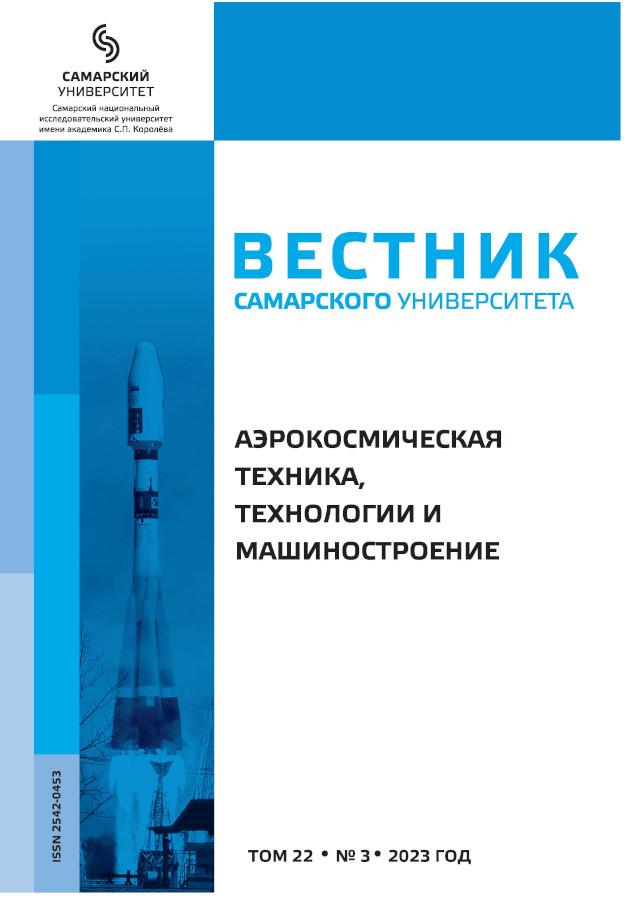Abrasive flow machining of specimens of cast billets from austenomartensitic steel with high-viscosity media
- Authors: Levko V.A.1, Teryaev N.S.1, Litovka O.V.1, Ivanov P.A.1
-
Affiliations:
- Reshetnev Siberian State University of Science and Technology
- Issue: Vol 22, No 3 (2023)
- Pages: 122-132
- Section: MECHANICAL ENGINEERING
- URL: https://journals.ssau.ru/vestnik/article/view/26894
- DOI: https://doi.org/10.18287/2541-7533-2023-22-3-122-132
- ID: 26894
Cite item
Full Text
Abstract
The paper presents the results of research on abrasive flow machining of removable specimens of cast billets made of austenomartensitic steel placed in a simulator of a closed curvilinear channel. The change in the roughness and micro-hardness of the surface of the samples was evaluated. There are two stages of machining. At the first stage of machining, most of the casting skin is removed. At the second stage, the casting skin is removed completely and the base metal layer is removed. It was established that the main mechanism for removing material from the surface of a cast billet is microcutting at the level of elementary real areas of contact of individual grain micro-protrusions. According to the results of the experiments, it is recommended to use abrasive flow machining with highly viscous medium to improve the roughness and increase the micro-hardness of the inner surfaces of the closed channels of cast billets.
About the authors
V. A. Levko
Reshetnev Siberian State University of Science and Technology
Author for correspondence.
Email: levkosaa@mail.ru
Doctor of Science (Engineering), Associate Professor, Professor of the Department of Mechanical Engineering Technology
Russian FederationN. S. Teryaev
Reshetnev Siberian State University of Science and Technology
Email: nikolay-teryaev@mail.ru
Associate Professor of the Department of Mechanical Engineering Technology
Russian FederationO. V. Litovka
Reshetnev Siberian State University of Science and Technology
Email: litovka.9518@gmail.com
Postgraduate Student
Russian FederationP. A. Ivanov
Reshetnev Siberian State University of Science and Technology
Email: Ivanov.pasch.iva@yandex.ru
Postgraduate Student
Russian FederationReferences
- Sysoev S.K., Sysoev A.S. Ekstruzionnoe khoningovanie detaley letatel'nykh apparatov: teoriya, issledovanie, praktika [Extrusion honing of aircraft parts: theory, research, practice]. Krasnoyarsk: Siberian State Aerospace University Publ., 2005. 219 p.
- Zubarev Yu.M. Spetsial'nye metody obrabotki zagotovok v mashinostroenii [Special methods of billet machining in mechanical engineering]. Saint-Petersburg: Lan' Publ., 2015. 400 p.
- Oborin L.A., Tyagunov G.V., Cherepanov A.I. Influence of steel production 08H14N7ML (VNL-1) on the degree of its equilibrium parameters of heat melt processing. Liteyshchik Rossii. 2013. No. 7. P. 25-29. (In Russ.)
- McCarty R.W. Method of honing by extruding. Patent US, no. 3521412, 1970. (Publ. 21.07.1970)
- Rhoades L.J. Abrasive flow machining for automatic surface finishing and capacitance technology for in-process surface and dimensional metrology. In: Surface Engineering. Dordrecht: Springer, 1990. P. 456-467. doi: 10.1007/978-94-009-0773-7_46
- Sysoev S.K., Sysoev A.S., Levko V.A., Snetkov P.A., Lubnin M.A. Ensuring the accuracy of the flow of fuel components through the channels of parts processed by extrusion honing. Tekhnologiya Mashinostroeniya. 2007. No. 6. P. 48-52. (In Russ.)
- Sysoeva L.P., Sysoev S.K., Sysoev AS. The technique for guarantee of quality of the aircraft detail channels with the use of abrasive flow machining process. Vestnik SibGAU. 2013. No. 2 (48). P. 228-232. (In Russ.)
- Tao Z., Yaoyao S., Xiaojun L., Tianran H. Optimization of abrasive flow polishing process parameters for static blade ring based on response surface methodology. Journal of Mechanical Science and Technology. 2016. V. 30, no. 3. P. 1085-1093. doi: 10.1007/s12206-016-0213-7
- Levko V.A., Savin D.I., Litovka O.V. Powder molybdenum alloy workpieces contact interactions under abrasive flow machining by high viscosity media. Proceedings of Irkutsk State Technical University. 2020. V. 24, no. 1 (150). P. 36-51. (In Russ.). doi: 10.21285/1814-3520-2020-1-36-51
- Petare A.C., Jain N.K. A critical review of past research and advances in abrasive flow finishing process. The International Journal of Advanced Manufacturing Technology. 2018. V. 97, Iss. 1-4. P. 741-782. doi: 10.1007/s00170-018-1928-7
- Levko V.A., Litovka O.V., Savin D.I., Terjaev N.S. Review of previous Russian studies in the abrasive flow machining. IOP Conference Series: Materials Science and Engineering. 2021. V. 1155, Iss. 1. doi: 10.1088/1757-899X/1155/1/012029
- Teryaev N.S., Volodin A.Yu. Feature the abrasive flow machining of hard alloys after investment casting. Aktual'nyye Problemy Aviatsii i Kosmonavtiki. 2015. V. 1, no. 11. P. 43-45. (In Russ.)
- Levko V.A. Contact processes in abrasive-extrusion processing. Metalloobrabotka. 2008. No. 3 (45). P. 19-23. (In Russ.)
- Gorana V.K., Jain V.K., Lal G.K. Forces prediction during material deformation in abrasive flow machining. Wear. 2006. V. 260, Iss. 1-2. P. 128-139. doi: 10.1016/j.wear.2004.12.038
- Shao Y., Cheng K. Integrated modelling and analysis of micro-cutting mechanics with the precision surface generation in abrasive flow machining. The International Journal of Advanced Manufacturing Technology. 2019. V. 105, Iss. 11. P. 4571-4583. doi: 10.1007/s00170-019-03595-4
- Levko V.A. Calculation of surface roughness in abrasive-extrusion machining on the basis of contact-interaction model. Russian Aeronautics. 2009. V. 52, Iss. 1. P. 94-98. doi: 10.3103/S1068799809010164
Supplementary files






















